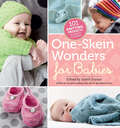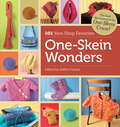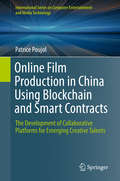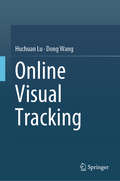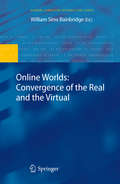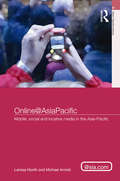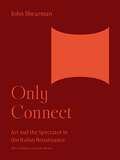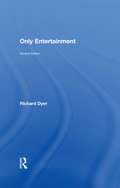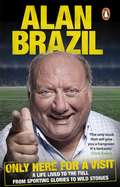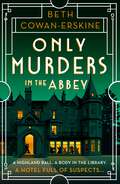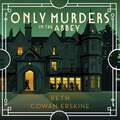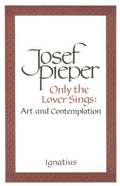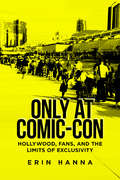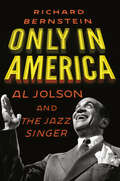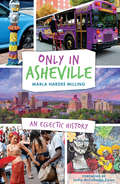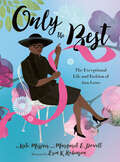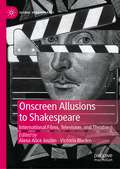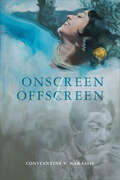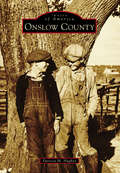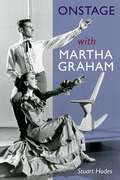- Table View
- List View
One-Skein Wonders® for Babies: 101 Knitting Projects for Infants & Toddlers (One-Skein Wonders)
by Judith DurantThis irresistible collection offers 101 original knitting projects for babies and toddlers — each using just a single skein of yarn! From mittens and hats to tees, sweaters, hoodies, pants, dresses, socks, and bootees, you’ll find the perfect wearable for every child and every occasion. You’ll also discover beautiful bibs, blankets, and sleep sacks, plus adorable stuffed toys, blanket buddies, and more. These beautiful projects were contributed by designers and crafters around the world, and each comes with complete step-by-step instructions and a photograph of the finished piece.
One-Skein Wonders®: 101 Yarn-shop Favorites (One-Skein Wonders)
by Judith DurantIf you’re like most knitters, you have lonely skeins of yarn in your closet — casualties of projects discarded mid-row or leftovers from long-completed pieces. Offering 101 charming designs that use just a single skein of yarn, Judith Durant shows you how to turn these extra bits of fiber into stylish hats, mittens, scarves, and tea cozies. Covering a wide range of tastes and styles, this collection will inspire you to dig out your orphan yarn and get stitching.
One-Track Mind: Drawing the New York Subway
by Jonathan Lethem Ezra Bookstein Jeremy WorkmanFor decades, Philip Ashforth Coppola has meticulously documented the New York City subway in a series of extraordinary drawings, detailing the terracotta mosaics, faience, and tile patterns that millions of riders pass by every day. Coppola's drawings are what Hyperallergic calls "the most encyclopedic history of the art and architecture of the New York City subway system." Along with Coppola's intricate ink drawings are anecdotes he assembled through painstaking research involving hundreds of hours poring through microfilms to discover the names behind the artisanship of what is rightly called New York's largest public art work—its legendary subway system.
One-Yard Wonders: 101 Sewing Fabric Projects; Look How Much You Can Make with Just One Yard of Fabric! (One-Yard Wonders)
by Patricia Hoskins Rebecca YakerDiscover all that you can make with just one yard of fabric! Rebecca Yaker and Patricia Hoskins offer 101 fun projects that use a single yard of fabric to make clothes, accessories, baby items, and more. With clear, step-by-step instructions, each project is designed to be completed in just a few hours. Get inspired and turn a yard of your favorite fabric into a quilted lunch bag, bright sundress, or a cuddly plush turtle.
Online Film Production in China Using Blockchain and Smart Contracts: The Development of Collaborative Platforms for Emerging Creative Talents (International Series on Computer Entertainment and Media Technology)
by Patrice PoujolThis book explores the use of Blockchain and smart contract technologies to develop new ways to finance independent films and digital media worldwide. Using case studies of Alibaba and in-depth, on-set observation of a Sino-US coproduction, as well as research collected from urban China, Hong Kong, Europe, and the USA, Online Film Production in China Using Blockchain and Smart Contracts explores new digital platforms and what this means for the international production of creative works. This research assesses the change in media consciousness from young urban audiences, their emergence as a potential participative and creative community within dis-intermediated, decentralised and distributed crowdfunding and crowdsourcing models. This research proposes solutions on how these young emerging local creative talents can be identified and nurtured early on, particularly those who now produce creative and artistic audiovisual content whether these works are related to film, Virtual Reality (VR), video game, graphic novels, or music. Ultimately, a new media content finance and production platform implementing blockchain is proposed to bring transparency in the film sector and open doors to emerging artists in digital media. Appropriate for both professionals and academics in the film industry as well as computer science.
Online Visual Tracking
by Huchuan Lu Dong WangThis book presents the state of the art in online visual tracking, including the motivations, practical algorithms, and experimental evaluations. Visual tracking remains a highly active area of research in Computer Vision and the performance under complex scenarios has substantially improved, driven by the high demand in connection with real-world applications and the recent advances in machine learning. A large variety of new algorithms have been proposed in the literature over the last two decades, with mixed success.Chapters 1 to 6 introduce readers to tracking methods based on online learning algorithms, including sparse representation, dictionary learning, hashing codes, local model, and model fusion. In Chapter 7, visual tracking is formulated as a foreground/background segmentation problem, and tracking methods based on superpixels and end-to-end deep networks are presented. In turn, Chapters 8 and 9 introduce the cutting-edge tracking methods based on correlation filter and deep learning. Chapter 10 summarizes the book and points out potential future research directions for visual tracking. The book is self-contained and suited for all researchers, professionals and postgraduate students working in the fields of computer vision, pattern recognition, and machine learning. It will help these readers grasp the insights provided by cutting-edge research, and benefit from the practical techniques available for designing effective visual tracking algorithms. Further, the source codes or results of most algorithms in the book are provided at an accompanying website.
Online Worlds: Convergence of the Real and the Virtual
by William Sims BainbridgeVirtual worlds are persistent online computer-generated environments where people can interact, whether for work or play, in a manner comparable to the real world. The most popular current example is World of Warcraft, a massively multiplayer online game with eleven million subscribers. However, other virtual worlds, notably Second Life, are not games at all but internet-based collaboration contexts in which people can create virtual objects, simulated architecture, and working groups. This book brings together an international team of highly accomplished authors to examine the phenomena of virtual worlds, using a range of theories and methodologies to discover the principles that are making virtual worlds increasingly popular, and which are establishing them as a major sector of human-centred computing.
Online@AsiaPacific: Mobile, Social and Locative Media in the Asia–Pacific (Asia's Transformations/Asia.com)
by Larissa Hjorth Michael ArnoldMedia across the Asia-Pacific region are at once social, locative and mobile. Social in that these media facilitate public and interpersonal interaction, locative in that this social communication is geographically placed, and mobile in so much as the media is ever-present. The Asia–Pacific region has been pivotal in the production, shaping and consumption of personal new media technologies and through social and mobile media we can see emerging certain types of personal politics that are inflected by the local. The six case studies that inform this book—Seoul, Tokyo, Shanghai, Manila, Singapore and Melbourne—offer a range of economic, socio-cultural, and linguistic differences, enabling the authors to provide new insights into specific issues pertaining to mobile media in each city. These include social, mobile and locative media as a form of crisis management in post 3/11 Tokyo; generational shifts in Shanghai; political discussion and the shifting social fabric in Singapore; and the erosion of public and private, and work and leisure paradigms in Melbourne. Through its striking case studies, this book sheds new light on how the region and its contested and multiple identities are evolving, and concludes by revealing the impact of mobile media on how place is shaped, as well as shaping, practices of mobility, intimacy and a sense of belonging. Employing comprehensive, cross-disciplinary frameworks from theoretical approaches such as media sociology, ethnography, cultural studies and media and communication studies, Online@AsiaPacific will be of huge interest to students and scholars of Asian culture and society, cybercultures, new media studies, communication studies and internet studies.
Only Connect: Art and the Spectator in the Italian Renaissance (The A. W. Mellon Lectures in the Fine Arts #37)
by John K.G. ShearmanA leading art historian’s plea for a more engaged reading of Italian Renaissance artOnly Connect constructs a history of Renaissance paintings and sculptures that are by design completed outside themselves by the spectator, that draw the spectator into their narrative plot or aesthetic functioning, and that reposition the spectator imaginatively or in time and space. John Shearman’s concern is mostly with anterior relationships with the viewer—that is, relationships conceived and constructed as part of a work’s design, making, and positioning. He proposes unconventional ways in which works of art may be distinguished from one another, and in which spectators may be distinguished as well, and enlarges the accepted field of artistic invention. Only Connect challenges us to recognize the presuppositions of Renaissance artists about their viewers, shining a light on the process of discovery by some of the most inventive and intellectual artists of the period.
Only Entertainment
by Richard DyerOnly Entertainment explores entertainment as entertainment, asking how and whether an emphasis on the primacy of pleasure sets it apart from other forms of art.Dyer focuses on the genres most associated with entertainment, from musicals to action movies, disco to porn. He examines the nature of entertainment in movies such as The Sound of Music and Speed, and argues that entertainment is part of a 'common sense' which is always historically and culturally constructed.This new edition of Only Entertainment features a revised introduction and five new chapters on topics from serial killer movies to Elizabeth Taylor. In the final chapter Dyer asks whether entertainment as we know it is on the wane.
Only Here For A Visit: A Life Lived to the Full – from Sporting Glories to Wild Stories
by Alan Brazil'The only book that will give you a hangover' Chris Evans Breakfast Show---The hilarious, no holds barred autobiography from sporting legend and broadcaster Alan Brazil.As Alan recounts tales from his extraordinary life, he relives the sporting occasions, radio broadcasts and famously long drinking sessions that have defined his career. He takes readers inside the talkSPORT studio for a behind-the-scenes view of his most memorable interviews, and talks for the first time about the on-pitch rivalries and dressing room debriefs of his footballing career.With his typically outspoken and irreverent delivery, Alan shares everything from his thoughts on how the sports he loves have changed to his top tips for picking winners (and many losers) at Cheltenham. And he revels in wine-soaked jaunts in the South of France and late-night supermarket sweeps with Ray Parlour - if you can keep up.Packed full of never-before-told stories, refreshing appraisals, sporting controversy and a cast of larger-than-life characters, this is a brutally honesty and wickedly funny insight into an extraordinary life.
Only Murders in the Abbey: An absolutely gripping and witty Golden Age cozy murder mystery (A Loch Down Abbey Mystery)
by Beth Cowan-Erskine'Wonderful read and a great whodunnit with all the intriguing clues and red herrings... I highly recommend this as a great read if you're looking for a murder mystery, a bit of humour and an escape' Reader review ⭐⭐⭐⭐⭐'Mrs MacBain, thank god it's you.' Without another word, he grabbed her arm and pulled her into the room, locking the door behind them. Mrs MacBain turned around, clearly offended at being manhandled, but then gasped, 'Is that blood?'Loch Down Abbey is full of guests for a Highland Ball. Including several uninvited members of the Inverkillen clan, the Abbey's former residents. Housekeeper Mrs MacBain thinks her biggest challenge will be finding suitable rooms for everyone and keeping the peace at cocktail hour.Until the morning after the ball, when one of the guests is discovered inside the Abbey's library - as dead as a doornail.Who would have had motive to want them dead? And how did they manage to commit their crime and escape while keeping the door locked from the inside? With an Abbey full of suspects and secrets, it is down to Mrs MacBain to catch the killer before they strike again... A brilliantly twisty and deliciously witty Golden Age murder mystery to transport you to 1930s Scotland. Perfect for fans of Agatha Christie, Janice Hallett and Richard Osman. Readers love Only Murders in the Abbey:'This cosy crime novel will keep readers on their toes... It's both a lot of fun to read and to try and work out the culprit' Reader review ⭐⭐⭐⭐⭐'Fun cosy murder story. Lots of colourful characters... Such a good mystery with a few twists and turns. A most enjoyable book' Reader review ⭐⭐⭐⭐⭐'Just brilliant' Reader review ⭐⭐⭐⭐⭐'A fabulously written gripping story that was a pleasure to read. I would absolutely recommend this book, it was brilliant' Reader review ⭐⭐⭐⭐⭐
Only Murders in the Abbey: An absolutely gripping and witty Golden Age cozy murder mystery (A Loch Down Abbey Mystery)
by Beth Cowan-Erskine'Mrs MacBain, thank god it's you.' Without another word, he grabbed her arm and pulled her into the room, locking the door behind them. Mrs MacBain turned around, clearly offended at being manhandled, but then gasped, 'Is that blood?' Loch Down Abbey is full of guests for a Highland Ball. Including several uninvited members of the Inverkillen clan, the Abbey's former residents. Housekeeper Mrs MacBain thinks her biggest challenge will be finding suitable rooms for everyone and keeping the peace at cocktail hour. Until the morning after the ball, when one of the guests is discovered inside the Abbey's library - as dead as a doornail. Who would have had motive to want them dead? And how did they manage to commit their crime and escape while keeping the door locked from the inside? With an Abbey full of suspects and secrets, it is down to Mrs MacBain to catch the killer before they strike again...
Only Murders in the Abbey: An absolutely gripping and witty Golden Age cozy murder mystery (A Loch Down Abbey Mystery)
by Beth Cowan-Erskine'Wonderful read and a great whodunnit with all the intriguing clues and red herrings... I highly recommend this as a great read if you're looking for a murder mystery, a bit of humour and an escape' Reader review ⭐⭐⭐⭐⭐'Mrs MacBain, thank god it's you.' Without another word, he grabbed her arm and pulled her into the room, locking the door behind them. Mrs MacBain turned around, clearly offended at being manhandled, but then gasped, 'Is that blood?'Loch Down Abbey is full of guests for a Highland Ball. Including several uninvited members of the Inverkillen clan, the Abbey's former residents. Housekeeper Mrs MacBain thinks her biggest challenge will be finding suitable rooms for everyone and keeping the peace at cocktail hour.Until the morning after the ball, when one of the guests is discovered inside the Abbey's library - as dead as a doornail.Who would have had motive to want them dead? And how did they manage to commit their crime and escape while keeping the door locked from the inside? With an Abbey full of suspects and secrets, it is down to Mrs MacBain to catch the killer before they strike again... A brilliantly twisty and deliciously witty Golden Age murder mystery to transport you to 1930s Scotland. Perfect for fans of Agatha Christie, Janice Hallett and Richard Osman. Readers love Only Murders in the Abbey:'This cosy crime novel will keep readers on their toes... It's both a lot of fun to read and to try and work out the culprit' Reader review ⭐⭐⭐⭐⭐'Fun cosy murder story. Lots of colourful characters... Such a good mystery with a few twists and turns. A most enjoyable book' Reader review ⭐⭐⭐⭐⭐'Just brilliant' Reader review ⭐⭐⭐⭐⭐'A fabulously written gripping story that was a pleasure to read. I would absolutely recommend this book, it was brilliant' Reader review ⭐⭐⭐⭐⭐
Only The Lover Sings: Art and Contemplation
by Josef Pieper Lothar KrauthThe popular and highly regarded Josef Pieper speaks of the necessity for human persons to be able to contemplate and appreciate beauty to develop their full humanity. Pieper expresses succinctly that the foundation of the human person in society is leisure, free time in which one can contemplate, be receptive to being and its beauty.
Only What's Necessary: Charles M. Schulz and the Art of Peanuts
by Chip Kidd Geoff SpearDrawn from the archives of the Charles M. Schulz Museum, an in-depth look at Peanuts with a “wealth of original art” (The New York Times).Charles M. Schulz believed that the key to cartooning was to take out the extraneous details and leave in only what’s necessary. For fifty years, from October 2, 1950, to February 13, 2000, Schulz wrote and illustrated Peanuts, the single most popular and influential comic strip in the world. In all, 17,897 strips were published, making it “arguably the longest story ever told by one human being,” according to Robert Thompson, professor of popular culture at Syracuse University. For Only What’s Necessary: Charles M. Schulz and the Art of Peanuts, renowned designer Chip Kidd was granted unprecedented access to the extraordinary archives of the Charles M. Schulz Museum and Research Center in Santa Rosa, California. Reproducing the best of the Peanuts newspaper strip, all shot from the original art by award-winning photographer Geoff Spear, Only What’s Necessary also features exclusive, rare, and unpublished original art and developmental work—much of which has never been seen before.“Glorious…equal parts museum and monument, a masterwork of curatorial rigor and an affectionate homage.”—Brain Pickings
Only at Comic-Con: Hollywood, Fans, and the Limits of Exclusivity
by Erin HannaWhen the San Diego Comic-Con was founded in 1970, it provided an exclusive space where fans, dealers, collectors, and industry professionals could come together to celebrate their love of comics and popular culture. In the decades since, Comic-Con has grown in size and scope, attracting hundreds of thousands of fans each summer and increased attention from the media industries, especially Hollywood, which uses the convention’s exclusivity to spread promotional hype far and wide. What made the San Diego Comic-Con a Hollywood destination? How does the industry’s presence at Comic-Con shape our ideas about what it means to be a fan? And what can this single event tell us about the relationship between media industries and their fans, past and present? Only at Comic-Con answers these questions and more as it examines the connection between exclusivity and the proliferation of media industry promotion at the longest-running comic convention in North America.
Only in America: Al Jolson and The Jazz Singer
by Richard BernsteinA probing biography of world-renowned Jewish singer and actor Al Jolson and the history of his performance in and the making of The Jazz SingerAl Jolson, born Asa Yoelson, immigrated from a shtetl in Lithuania to the United States in 1894 after his father secured a job as a rabbi in Washington, D.C. A poor, Yiddish-speaking newcomer navigating a racially segregated and antisemitic America, young Jolson dreamed of becoming a star, and he did. Thanks to his immense talent and his knack for assimilating into new environments, by the time he reached his twenties he was the most famous and highly paid entertainer in America, making almost $5,000 a week at a time when the average American made $800 a year. Jolson&’s public adoration and widespread acceptance as a star marked the beginning of an enriching cultural transformation, a moment when the American mind opened up to ethnic and racial differences, widening the gap of acceptability. And yet Jolson himself, despite being ferociously ambitious and gigantically talented, was crippled by insecurity, often nervous to the point of collapse, prisoner to his many vices.Through Jolson, Bernstein simultaneously breaks open the history and legacy of the cultural sensation The Jazz Singer. Not only was The Jazz Singer the first feature length film with synchronized music and dialogue, but it was also taboo smashing in its content: The Jazz Singer is all about Jews, Orthodox and otherwise. Bernstein expounds on the making of The Jazz Singer, what the film meant then and now, introducing the many individuals involved in its production, including Samson Raphaelson, a young Jewish writer whose short story was the basis for the movie; the four Warner brothers, who made a fortune off it; and George Jessel, Jolson&’s rival and the star of Raphaelson's stage adaptation of his short story. In the background emerges a picture of old Hollywood in the Roaring Twenties: cutthroat and greedy yet visionary and progressive. And while The Jazz Singer represented the future in many ways, it also dredged up the worst of the past, including Jolson&’s use of blackface, common at the time.At once a tale of the Judaizing of American culture and an acknowledgment of the challenges to come, Only in America is a glistening examination of a man at the center of a watershed moment in the arts.
Only in Asheville: An Eclectic History
by Marla Hardee Milling Leslie Mccullough CasseA unique blend of visionaries, risk takers and creative souls lends energy to Asheville's historic streets. Today, bohemian street performers, funky shops, exquisite art galleries, restaurants and craft breweries blend in among some of the most revered vintage architecture in the country. Discover quirky figures like a "nun" named Sister Bad Habit, who entertains passengers on the LaZoom bus; the "Man in White" living statue; and Asheville's Village Witch. Be inspired by innovative dreamers such as Julian Price, who invested millions in the once-desolate downtown Asheville, giving money to an eclectic mix of restaurateurs and shop owners. Author Marla Milling traces the people and places that make her hometown a truly unique city.
Only the Best: The Exceptional Life and Fashion of Ann Lowe
by Kate Messner Margaret E. PowellAn inspiring picture book biography of the amazing Anne Lowe, the first nationally-known African American fashion designer! A careful snip, a delicate fold.Fabric the color of new petals.Skirts that flare like upside-down blossoms.A garden bursts into bloom! There is no "good enough."For Ann, only the best will do. Award-winning author Kate Messner, costume historian Margaret E. Powell, and fashion designer and illustrator Erin Robinson tell the powerful story of the ground-breaking Ann Lowe, who grew up in a small Alabama dress shop and became the first nationally-known African American fashion designer. Sought after by millionaires and movie stars, her designs walked the red carpet and graced the wedding of Senator John F. Kennedy and Jacqueline Bouvier. At a time when the world around her thought African Americans deserved no more than second-class treatment, Ann expects no less of herself, and no less FOR herself, than the BEST. THE FIRST, FAMED BLACK FASHION DESIGNER: Although she faced many hardships, Anne's spirit, talent, and belief in herself always shone through. This story provides an empowering, real-life role model for young girls—and especially Black girls—to relate to and see themselves in, at an age when building self-confidence is more important than ever! ENCOURAGES CREATIVITY AND PERSERVERENCE: Full of interesting details about how Anne came up with her designs, and how she always forged ahead in spite of setbacks, this true story will captivate aspiring artists and young creative thinkers alike. SURE OF HER OWN WORTH: This book makes a perfect gift for anyone looking to celebrate, empower, and inspire the women in their lives—whether daughters, granddaughters, nieces, cousins, or friends. Ann Lowe stands as a testament to the power of knowing we're both capable of and deserve ONLY THE BEST. BEAUTIFUL, IMMERSIVE PROSE: Wonderful, vivacious writing by award-winning author Kate Messner and expert historian Margaret E. Powell brings Anne's pride in herself and her work to life in rich detail! Perfect for:Parents, grandparents, and caregiversTeachers and librariansReaders who loved Little Leaders and Parker Looks UpThe vast #WeNeedDiverseBooks communityAnyone seeking books about Black excellence, female empowerment, or Black historyGift-givers looking for a beautiful, inspirational book for the girls (or women) in their lives
Onscreen Allusions to Shakespeare: International Films, Television, and Theatre (Global Shakespeares)
by Alexa Alice Joubin Victoria BladenAllusions to Shakespeare haunt our contemporary culture in a myriad of ways, whether through brief references or sustained intertextual engagements. Shakespeare’s plays and motifs have been appropriated in fragmentary forms onstage and onscreen since motion pictures were invented in 1893. This collection of essays extends beyond a US-UK axis to bring together an international group of scholars to explore Shakespearean appropriations in unexpected contexts in lesser-known films and television shows in India, Brazil, Russia, France, Australia, South Africa, East-Central Europe and Italy, with reference to some filmed stage works.
Onscreen/Offscreen (Studies in the Anthropology of Language, Sign, and Social Life)
by Constantine V. NakassisBased on over a decade of ethnographic fieldwork in the South Indian state of Tamil Nadu, Onscreen/Offscreen is an exploration of the politics and being of filmic images. The book examines contestations inside and outside the Tamil film industry over the question "what is an image?" Answers to this question may be found in the ontological politics that take place on film sets, in theatre halls, and in the social fabric of everyday life in South India, from populist electoral politics and the gendering of social space to caste uplift and domination. Bridging and synthesizing linguistic anthropology, film studies, visual studies, and media anthropology, Onscreen/Offscreen rethinks key issues across a number of fields concerned with the semiotic constitution of social life, from the performativity and ontology of images to questions of spectatorship, realism, and presence. In doing so, it offers both a challenge to any approach that would separate image from social context and a new vision for linguistic anthropology beyond the question of "language."
Onset and Point Independence (Postcard History)
by Michael J. MaddiganInaugurated in 1877 as a camp meeting ground by eastern Massachusetts residents who believed in communication with the dead, Onset quickly emerged as the nation's leading spiritualist summer community. By 1900, however, spiritualism had been overwhelmed by an influx of tourists, and Onset subsequently developed as a secular summer resort noted for its scenic bluffs, recreational pursuits, and beaches. At this same time, neighboring Point Independence found wide appeal among middle-class vacationers interested in swimming, sailing, and relaxation.
Onslow County (Images of America)
by Patricia M. HugheyOnslow County is one of the oldest maritime and agricultural counties on the southeastern coast of North Carolina. Originally inhabited by indigenous peoples, the area was settled in the early 18th century by a diverse group of people, including farmers, merchants, indentured servants, and slaves, hailing not only from nearby colonies but also from the British Isles and West Indies. This diversity has continued into the 21st century; Onslow's citizens have arrived from virtually every state and from several foreign countries due to the military presence of Camp Lejeune and New River Air Station. But there remains a nucleus population of families that descended from those early-18th-century pioneers--a thread that provides continuity into the present. These old-timers always appreciate and enjoy the history of their familiar surroundings, while newer residents want to learn more about the place they now call home.
Onstage with Martha Graham
by Stuart HodesWhen World War II was over, a young bomber pilot with an itch for movement and action hung up his cap and learned another way to fly. Onstage with Martha Graham is the story of Stuart Hodes, a versatile and influential dancer who got his start with Martha Graham, an icon of modern dance. His memoir is a rare firsthand view of the dance world in the 1940s and through the end of the twentieth century. One of the few male dancers in Graham’s company—and in the New York dance scene at the time—Hodes offers a unique perspective and a one-of-a-kind narrative. He describes how he fell into the art by chance, happening to walk into Graham’s studio one day. He was soon hooked. He documents his experiences, travels, passions, and loves while learning from and performing with Graham, during which time he saw most of the United States, much of Europe, and some of Asia. Advancing quickly, he eventually danced as Graham’s partner in Appalachian Spring, Deaths and Entrances, Every Soul Is a Circus, and Errand into the Maze. In his portrait of Martha Graham, who was the center of his dancing world, Hodes recounts conversations, revelations, bouts of temper and creativity, the daily ritual of deeply physical dancing, and the never-ending search for artistic validity. Direct, often humorous, and always authentic, Hodes shares his delight in dance as both hard work and a fantastic adventure.
